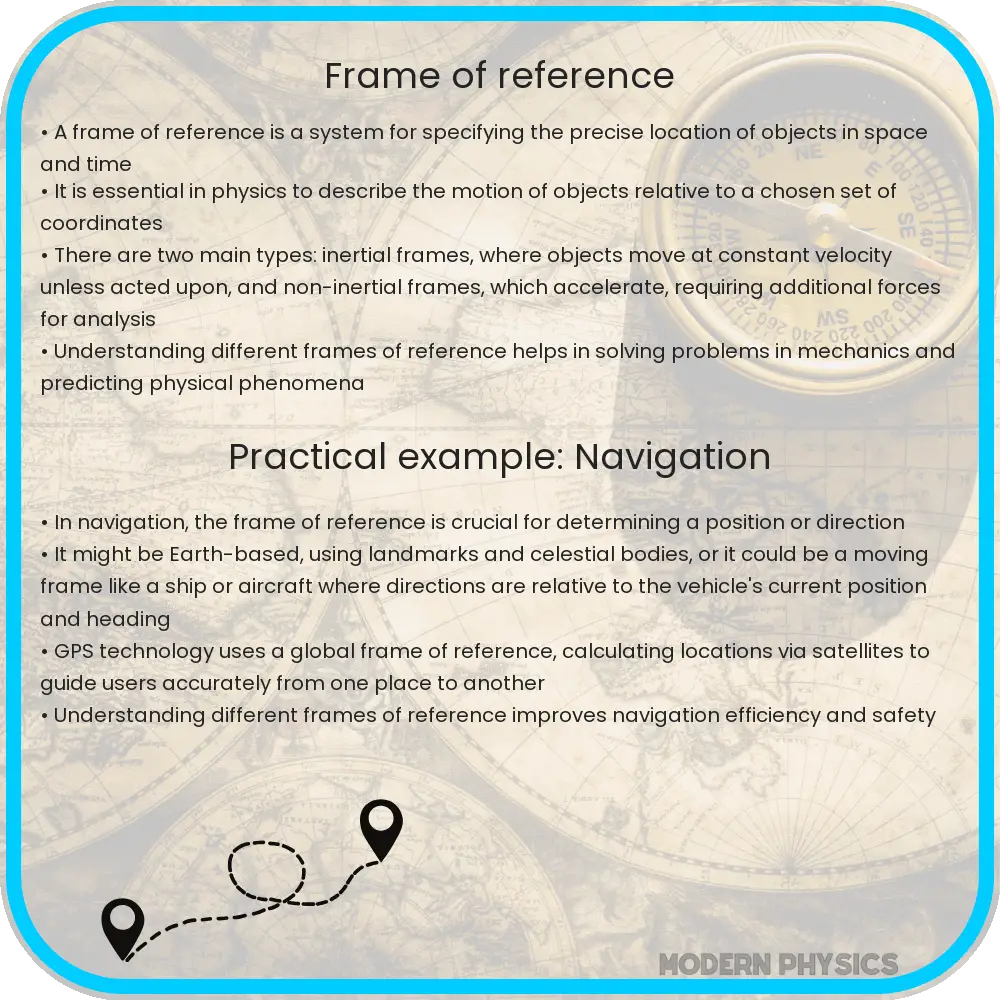Frame of reference: A coordinate system to measure positions and times of events, crucial in understanding motion in classical mechanics and special relativity.

Frame of Reference | Special Relativity, Motion & Observers
Understanding motion and how it is observed in physics is crucial. A central concept that helps us make sense of these observations is the frame of reference. This concept is essential in both classical mechanics and Einstein’s theory of special relativity. Let’s delve into what a frame of reference is and how it applies to these fields.
What is a Frame of Reference?
A frame of reference is essentially a coordinate system used to measure the position and time of events. It includes an observer (or multiple observers) and a set of axes. For example, if you are standing on a train platform watching a train go by, your frame of reference is the platform. Alternatively, for someone onboard the train, their frame of reference is the train itself.
Motion and Observers
In physics, motion is always measured relative to a frame of reference. This means that how we observe and measure motion depends on the observer’s viewpoint. For instance, imagine two people are observing a car driving down a street:
- A person standing on the sidewalk sees the car moving.
- A person sitting inside the car perceives that they are stationary, while the world outside seems to move past them.
This difference in perception illustrates the importance of the frame of reference. Each observer is correct in their own context, but they will have different descriptions of the car’s motion.
Special Relativity and Frames of Reference
Albert Einstein’s theory of special relativity fundamentally changed our understanding of time and space by considering the effects of moving frames of reference at high speeds, close to the speed of light. The key ideas include:
- The laws of physics are the same in all inertial frames of reference (frames moving at constant velocity relative to each other).
- The speed of light, c, is the same for all observers, regardless of their relative motion or the motion of the light source.
Relativity of Simultaneity
One of the intriguing consequences of special relativity is the relativity of simultaneity. Events that are simultaneous in one frame of reference might not be simultaneous in another. An example can illustrate this concept:
- Imagine two lights flash simultaneously at opposite ends of a moving train.
- An observer standing on the station platform would see the lights flash at different times because the train is moving.
- An observer on the train would see the lights flash simultaneously.
This happens because the speed of light is constant, and the distance between the events and the observers changes based on the frame of reference.
Time Dilation
Another fascinating outcome of special relativity is time dilation. This phenomenon means that time can pass at different rates in different frames of reference. Specifically, time appears to move slower for objects moving at high speeds relative to a stationary observer. This effect can be described by the equation:
\[ t’ = \frac{t}{\sqrt{1 – v^2 / c^2}} \]
where t’ is the time measured in the moving frame of reference, t is the time measured in the stationary frame of reference, v is the relative velocity, and c is the speed of light.
For instance, if an astronaut travels in a spaceship at a significant fraction of the speed of light, their clock would tick slower compared to a clock on Earth. When the astronaut returns, they would be younger than if they had stayed on Earth.
Length Contraction
Length contraction is another key component of special relativity. It states that objects moving at high speeds will appear shorter along the direction of motion to a stationary observer. The equation for length contraction is:
\[ L’ = L \sqrt{1 – v^2 / c^2} \]
where L’ is the contracted length observed, L is the proper length (the length of the object at rest), v is the relative velocity, and c is the speed of light.
For example, if a spaceship were to travel close to the speed of light, it would appear significantly shorter in the direction of travel to a stationary observer on Earth.
Conclusion
Understanding frames of reference is crucial in both classical mechanics and special relativity. They shape how we measure motion and perceive events. In classical mechanics, different observers may have different descriptions of motion depending on their frames of reference. Special relativity introduced revolutionary concepts like the invariance of the speed of light, time dilation, and length contraction, which show that our intuitions about time and space are not always correct at high velocities.
By mastering these foundational concepts, we gain insight into the intricate and fascinating nature of our universe. Whether observing from a train platform or traveling at near-light speeds, frames of reference profoundly impact our understanding of reality.
